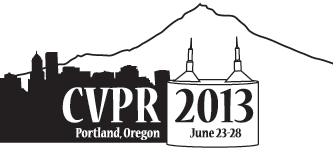-
Tracking Human Pose by Tracking Symmetric Parts
AbstractThe human body is structurally symmetric. Tracking by detection approaches for human pose suffer from double counting, where the same image evidence is used to explain two separate but symmetric parts, such as the left and right feet. Double counting, if left unaddressed can critically affect subsequent processes, such as action recognition, affordance estimation, and pose reconstruction. In this work, we present an occlusion aware algorithm for tracking human pose in an image sequence, that addresses the problem of double counting. Our key insight is that tracking human pose can be cast as a multi-target tracking problem where the "targets" are related by an underlying articulated structure. The human body is modeled as a combination of singleton parts (such as the head and neck) and symmetric pairs of parts (such as the shoulders, knees, and feet). Symmetric body parts are jointly tracked with mutual exclusion constraints to prevent double counting by reasoning about occlusion. We evaluate our algorithm on an outdoor dataset with natural background clutter, a standard indoor dataset (HumanEva-I), and compare against a state of the art pose estimation algorithm.
Related Material
[pdf][bibtex]@InProceedings{Ramakrishna_2013_CVPR,
author = {Ramakrishna, Varun and Kanade, Takeo and Sheikh, Yaser},
title = {Tracking Human Pose by Tracking Symmetric Parts},
booktitle = {Proceedings of the IEEE Conference on Computer Vision and Pattern Recognition (CVPR)},
month = {June},
year = {2013}
}
These CVPR 2013 papers are the Open Access versions, provided by the Computer Vision Foundation.
Except for the watermark, they are identical to the accepted versions; the final published version of the proceedings is available on IEEE Xplore.
Except for the watermark, they are identical to the accepted versions; the final published version of the proceedings is available on IEEE Xplore.
This material is presented to ensure timely dissemination of scholarly and technical work.
Copyright and all rights therein are retained by authors or by other copyright holders.
All persons copying this information are expected to adhere to the terms and constraints invoked by each author's copyright.

